#Lev Manovich
Explore tagged Tumblr posts
Text
youtube
What kind of cinema is appropriate for the age of Palm Pilot and Google? Automatic surveillance and self-guided missiles? Consumer profiling and CNN? To investigate this question, Lev Manovich, one of today's most influential thinkers in the fields of media arts and digital culture, paired with award-winning new media artist and designer Andreas Kratky. They have also invited contributions from leaders in other cultural fields: DJ Spooky, Scanner, George Lewis, and Johann Johannsson (music), servo (architecture), Schoenerwissen/OfCD (information visualization), and Ross Cooper Studios (media design). The results of their three-year explorations are the three "films" presented on this DVD. Although the films resemble the familiar genres of cinema, the process by which they were created demonstrates the possibilities of soft(ware) cinema. A "cinema," that is, in which human subjectivity and the variable choices made by custom software combine to create films that can run infinitely without ever exactly repeating the same image sequences, screen layouts and narratives. Mission to Earth, a science fiction allegory of the immigrant experience, adopts the variable choices and multi-frame layout of the Soft Cinema system to represent "variable identity." Absences is a lyrical black and white narrative that relies on algorithms normally deployed in military and civilian surveillance applications to determine the editing of video and audio. Texas, a "database narrative," assembles its visuals, sounds, narratives, and even the identities of its characters, from multiple databases. The DVD was designed so that every viewing of each film generates a different version.
2 notes
·
View notes
Text
Blog post 4.
Photorealism in Digital Media
"In the 20th century, different areas of commercial moving image culture maintained their distinct production methods and distinct aesthetics. Films and cartoons were produced completely differently and it was easy to tell their visual languages apart. Today the situation is different. " (Manovich 2006).
The medium through which we consume art has all moved towards a computer screen. (Manovich 2006). the computer screen where we today enjoy our films, animations, photography games, etc. has resulted in the physical differences between the medium to blur.today this competer screen is increasingly the one in our pockets Result of technological progress and optimization. another parallel can be seen in the way all technological needs are served by a singular device, our phone. while in the past we used to have different ones with different purposes, for example, phones, walkmans, cameras, and notepads.

There has been a shift away from hardware to software in technology starting from the 1980s when hardware which is case specific is replaced with a general-purpose computer and the software which is programming can perform multiple functions.
while this melding of different mediums occurs there has been a trend towards photorealism in this new hybrid visual language. this is true in many different mediums but perhaps the most apparent in games. where the games are often reduced to tech demos showcasing the latest in rendering technology rather than artworks with engaging gameplay or interesting art styles (Masuch, M. and Röber, N., 2005)
What's the point of faking cinematic imagery in games or animation? like motion blur or lens flare in games?is it that photographic imagery is far more prevalent and respectable? is it an attempt to hide the digital artificiality of CGI with a patina of cinema? which is tangibly more real. is it that the new medium is just imitating the older more established medium? (Manovich 2006).
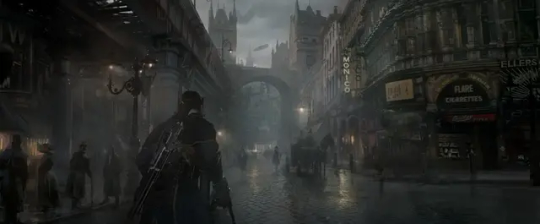
The Order 1886, A game praised for its photorealistic and cinematic graphics, still failed because of bad gameplay and story.
Photographic realism is the standard or default visual reflection of the real world. or at least it has occupied that position for a long time. It offers the closest parallel to how the human eye actually sees everything. it's not clear though whether this is an obvious fact of nature or is the result of people being surrounded by photographs as the primary source of visual communication. most cultures throughout history when representing reality, chose an abstract form of doing it. maybe suggesting that our natural way of perception isn't obviously photorealistic. this also asks the question is art about simulating reality or sampling it? (Manovich 2006).
another reason might have been that the various styles of art and aesthetics that have existed have been a negotiation between three things natural biological need to communicate, a need for artistic expression, and the limitations of any physical medium and processes that have to be taken care of while making anything tangible.
However, the process and tools of expression are more accessible and have few steps involved that deal with the tangible. the shift towards photorealism continues. example. the live-action Disney films. the style of 2d animation seen in classic Disney films was very much informed by the medium. to a line drawing with flat colors simplified, exaggerated, and simplified features and expressions are an optimal way of expression on a piece of paper. which in turn informed the style. but now that the technical limitations aren't there, Disney has abandoned what was once a style, now a limitation. these media-specific qualities are what should be highlighted (Greenberg, C. 1960) but results have often been very different. even the stylization in 3d animation seen in many animated art forms today can be seen as a vestigial effect. only to be ironed out slowly.
This relationship can also be understood the other way around. Films have seamlessly blended transitions from one medium to the other and then back. the least noticeable might be the transitions in 1917. at what point a film could be considered not a film but a hybrid medium? or even an animation with film aspects? Many of the Marvel films have more CGI than actual footage.
Sources-
⦁ Manovich, L., 2006. Image Future. [online] Available at: https://manovich.net/content/04-projects/048-image-future/45_article_2006.pdf [Accessed 28 December 2024].
⦁ Masuch, M. and Röber, N., 2005. Game Graphics Beyond Realism: Then, Now, and Tomorrow. Otto-von-Guericke University Magdeburg, Games and Graphics Research Group, Institute for Simulation and Computer Graphics. Available at: https://www.researchgate.net/publication/252486461 [Accessed 28 Dec. 2024].
⦁ Greenberg, C. (1960). Modernist Painting. In: Forum Lectures. Voice of America.
0 notes
Text
this midterm essay is one of the only times im worried about going Over the page count but the topic is just so cool
#im summarizing New Media: A User's Guide by lev manovich#its a really interesting read and put media development into a new perspective for me#text#its only like 7 pages highly recommend
15 notes
·
View notes
Text
Before the Glitch: “Stylized Repetition” and Gender Performance in the Online Mainstream
By: Andromeda 🌊🪨
In the introduction to her book Glitch Feminism: A Manifesto, Legacy Russell writes, “Online, I sought to become a fugitive from the mainstream, unwilling to accept its limited definition of bodies like my own.” The “real world,” or the world “AFK” (Away From Keyboard) involves an immediate and fixed form of visibility, and thus pressure to conformity that the digital one doesn’t necessarily demand. However, as Russell writes, the “artifice of a simple digital Shangri-La” has been “punctured”– escaping the mainstream isn’t as simple as logging on. As all worlds do, the digital world is dominated by a “mainstream”, one rife with the “incessant white heteronormative observation” that Russell describes in her “AFK” to be fraught with. So what exactly does this digital mainstream look like? How do we “construct and perform” our “gendered self,” as Russell puts it, in the language of social media?
As a university student, meeting people typically demands 3 obligatory pieces of information: name (to be immediately forgotten), major (to be vaguely commented on), and Instagram account (to follow, and thus cement your new acquaintanceship. Also, to remind you of the name you just forgot). Despite what self-proclaimed “free spirits” and “casual-Instagrammers” will tell you, your Instagram is not just a photo-album for you to look back on, or a journal in which to document the events of your life. That’s what photo-albums and journals are for, people! It’s an image of yourself designed for presentation, the digital face you present to old friends and new acquaintances alike: it’s your own curation of exactly how you want to be perceived, neatly packaged in rows of three. On Instagram, “performing [one’s] gendered self” under “incessant white heteronormative observation” is the name of the game. Personally, I would even venture to say that any online presence is an inherently exhibitionistic one. If you disagree with me on that one, fine. Go write about it on your tumblr.
What you can’t argue is that using Instagram, arguably the most popular social media platform today, is an exercise that begs for observation, for engagement, for the imposition of opinions and identifiers. In Camera Lucida: Reflections on Photography, Roland Barthes (one of the only tolerable men that France has ever produced) writes, “every photograph is a certificate of presence.” Let’s for the moment table (read: ignore) the complications of technological tampering on the semiotic-ontological-whatever relationships between photo and subject raised by the likes of Stephen Prince and Lev Manovich (as neither of us have the time for that), and take what Barthes says at face value.
If a photo is a certificate of presence, we can consider Instagram to be a glass case of certificates of your choosing still and pristine as they tell the story of digital you, spectated you, ossified you. And here’s the kicker: you’re not only on display in the case, but you’re on display as the person who curated it. If you’re a pretentious asshole like myself, you can think of these curatorial choices as the metalanguage of your Instagram (I warned you!). What, with whom, and how often you post all exist in the context of your choice to post at all, and the fact that every post has an agenda (regardless of what that agenda might be). Each post is a stylistic choice, a piece added to the puzzle of one’s digital identity.
In Performative Acts and Gender Constitution, Judith Butler (who happens to be the celebrity hall-pass of a friend of mine) describes gender identity as, "an identity instituted through a stylized repetition of acts. Further, gender is instituted through the stylization of the body and, hence, must be understood as the mundane way in which bodily gestures, movements, and enactments of various kinds constitute the illusion of an abiding gendered self."

I feel that this passage (along with facilitating my understanding of the hall-pass thing–I can think of bodily movements of various kinds that I’d like to repeat in a stylized manner with Judith) is easily translated to the idea of gender performance online. What are posts, if not stylized acts? Lighting, pose, caption–every element is designed to, quite literally, cultivate an image. The sharing of posts, how they accumulate and interact, are acts of stylized repetition that, whether we know it or not, construct our digital identities.
As an example, take a look at this TikTok, which outlines a “recipe for a perfect photo dump.” A photo dump is a group of photos collected in one carousel Instagram post, typically designed to look effortless. But the detailed instructions in this post (including one “effortless photo”, an “outfit pic”, and a “personality pic” amongst others) exemplify a guideline for the exact kind of “stylization of the body” (albeit a digital one) that Butler describes, meticulously designed to communicate an identity. Even the arrangement of our Barthesian certificates of presence (the TikToker has graciously numbered each picture, so they may be ordered “perfectly”), is paramount in constructing our digital selves.
“The glitch,” Russell writes, “acknowledges that gendered bodies are far from absolute but rather an imaginary, manufactured, and commodified for capital.” What an unbearably fierce and pithy way to phrase how the body exists in the digital mainstream! From clean-girl to rat girl to coquette girl to messy girl (this one strikes me as particularly ironic–who knew there were so many rules to being messy?), it never fucking stops! These inflexible hole-in-the-wall shapes that we contort ourselves into through our online behaviour generate the same kind of frustration in me that led me to memorize the cool girl monologue in high-school. These trends and their proponents demand of us, as Russell writes, “a gender performance that fits within a binary in order to comply with the prescriptions of the everyday.” Unspoken rules and categories like these are just as, if not more, stifling than those in the mainstream that exists AFK.
Russell’s manifesto calls to mind one of my favourite winners of RuPaul’s Drag Race, Sasha Velour, and her verse in ‘Category Is…’, the song performed by the season’s final four competitors. There are a few lines in there that I think Russell might enjoy:
Wear a crown
Fuck with gender
Bend the rules
Don’t surrender

Sounds about right to me! The next time you see a clean-girl TikToker’s hair tutorial or diet plan or morning routine, just take three deep breaths, and think of Sasha. And you think hard enough, who knows? Maybe the force of your psychic energy will crack her forty-dollar gua sha.
2 notes
·
View notes
Text
History, Narrative, and the Cybernetic-Structuralist Database
Is what Roland Barthes called the “structuralist activity” an algorithm? Structuralism certainly seems to proceed, in its various instantiations, in an algorithmic manner, setting up rules that could be used to process any data loaded into the memory of literary analysis. Barthes defines the "activity" as “the controlled succession of a certain number of mental operations” (1963, 214). For structuralism, these are primarily operations of decomposition and recomposition, taking “the real” as an input, “decomposing and recomposing” it in an operational form to be worked on by the new literary scientists (215). An algorithm, strictly speaking, is a finite set of explicit and definite steps that takes an input and yields an output (Knuth 1997, 4–6). Of course, the “structuralist activity” is not literally an algorithm—its steps are by no means definite, even within the oeuvres of individual authors—but it does emphasize machine-like operations, foregrounding the ways in which it formalizes its concepts: by means of measure, selection, permutation, binary opposition, code, unit, function, and so forth, all terms which would not have been commonly found in traditional studies of literary language, which was largely philological and rhetorical (what Barthes calls the “old Rhetoric”). The “new Rhetoric” of structuralism was an attempt to confront “the new semiotics of writing,” and the “modern text, i.e., the text which does not yet exist” (Barthes 1985, 11).
The structural analysis of the “modern text” turns out to be closely—though not exhaustively or exclusively—engaged with the digital and the computational: a digital humanities avant la lettre. It is not only coincidentally similar in its broad outlines to developments in algorithmic and information-technological thinking, but actively drew on such thinking, transcoding it into cultural and literary studies (and at times subverting it, by extending it to an absurd degree). The foundational texts of structuralist narratology, in particular—such as those published by the journal of the Centre d’études des communications de masse [Center for the Study of Mass Communications] (CECMAS) at the École Pratique des Hautes Études in Paris, authored by theorists like Barthes, Claude Bremond, Gérard Genette, Tzvetan Todorov, Umberto Eco, A.-J. Greimas, Christian Metz, and others—introduce a database logic that sometimes seems to threaten the epistemic dominance of narrative, creating anxieties about the disappearance of historical meaning. This tension between databases and narratives, which Lev Manovich emphasizes much later in his book The Language of New Media (2001), is of course still relevant today, amidst major expansions of data science, artificial intelligence, algorithmic culture, and computational literary studies. A return to the history of structuralism and semiology and its genesis in what Ronald R. Kline calls the “cybernetics moment” reveals that much of the cultural-technical background has been lost in the reception of these innovative twentieth-century approaches.
Bernard Dionysius Geoghegan has recently shown (2023) how so-called French structuralism emerged from a circuit of trans-Atlantic exchange between the human sciences in Europe and the new “universal sciences” of communication and control in North America (cybernetics, information theory). European émigrés like Roman Jakobson and Claude Lévi-Strauss were among the first to popularize the hybridization of Saussurean linguistics with these new sciences: Jakobson with his reinterpretation of the Shannon-Weaver model of communication (channels and messages, senders and receivers), and Lévi-Strauss with his ambitions of organizing the large-scale storage and processing of (largely endangered) myths. Both received support from major US private philanthropic and government institutions, such as the Rockefeller Foundation and the CIA-founded Center for International Studies at the Massachusetts Institute of Technology. Later, in the 1960s, scholars like Barthes, responding to the technocratic, scientistic ambitions of the French state and its modernizing universities, would also take up cybernetic-structuralist thought. But they would do so more ironically than their predecessors. CECMAS, founded in 1960 by sociologist Georges Friedmann (with assistance from Barthes, Edgar Morin, and Violette Morin), became a launch pad for what Geoghegan calls “crypto-structuralism,” a retranslation of cybernetics and information theory, undertaken after these ideas had already been circulating between the US and France for around a decade. This loose group, which included Jean Baudrillard and Julia Kristeva among those already mentioned, did not reject cybernetics altogether, as many of its peers did. But it also did not import cybernetic concepts wholesale. In the writing of “crypto-structuralists” like Barthes, as we have already begun to see, there is a historicizing tendency that suggests that these thinkers may have viewed cybernetics as an interesting and useful apparatus for contending with a period of rapid information-technological change, and not necessarily as a universally applicable strategy.
One of the most influential issues of Communications, the journal of CECMAS, is the 1966 issue on narrative (“Recherches sémiologiques : l'analyse structurale du récit”). Yet narrative is largely absent from the North American communications research that CECMAS convened to study. Information theory and cybernetics are not theories of narrative; in some ways, they are antithetical to traditional concepts of narrative. The information theory of Shannon and Weaver, first published in 1948, consists of a set of five elements: an information source, a transmitter, a channel, a receiver, and a destination. A message from the source is “selected” and encoded into a technical signal, transmitted along an insulated channel, decoded by a receiver, and arrives, reconstituted, at its destination. According to this model, the channel is ideally always open, and noise-free. Similarly, cybernetics, at least as articulated by Norbert Wiener, does not deal with narratives but time series and feedback loops, seeking to develop a science of the “real-time” prediction of future behavior from past behavior in the direction of a system. Information theory and cybernetics are both probabilistic: they are oriented toward the optimization of systems according to patterns that are statistically likely. Where narrative is a recounting, these are systems of counting.
But the structural narratologists show us that recounting and counting are not necessarily so foreign to one another, or at least that it may be worth modeling the former in terms of the latter, as a kind of experiment in translation. Barthes, in an early statement on CECMAS in the social history journal Annales, uses terminology from information theory to describe the primary concept of structural analysis: the unité informative, the “smallest component element of a set.” CECMAS’s project, according to Barthes, is to investigate the ambiguity of this unit of information, which is two-sided, both quantitative and qualitative, statistical and structural, numerical and functional. It is not a matter of choosing between these two alternatives, says Barthes. Rather, “both paths are open to the mass-media researcher: such is the breadth and novelty of the work ahead” (1961, 992; my translation). Accordingly, the statistical thinking associated with information theory and cybernetics (to which we might also add game theory, decision theory, and operational research) consistently makes its way into the narratological work done by the structuralists: more or less all structural analyses of narratives begin by pronouncing the need for compression algorithms or source-codes, sets of rules that would allow us to know how narrative works without needing to read each and every narrative (an eternal task). In the Saussurean tradition, instead of following narratives primarily on the diachronic axis (as paroles), structuralism transforms them into relations on the synchronic axis (as langue). In the vocabulary of Shannon and Weaver, we might view this as the optimization of a narratological apparatus according to the “statistical structure” of narratives.
In his “Introduction to Structural Narratology” (1960), Barthes foregrounds structuralism’s idiosyncratic approach to narrative. “It has already been pointed out that structurally narrative institutes a confusion between consecution and consequence, temporality and logic. This ambiguity forms the central problem of narrative syntax. Is there an atemporal logic lying behind the temporality of narrative?” (98) An “atemporal matrix structure,” as Lévi-Strauss calls it, absorbs chronological succession. “Analysis today,” Barthes continues, “tends to ‘dechronologize’ the narrative continuum and to ‘relogicize’ it . . . the task is to succeed in giving a structural description of the chronological illusion—it is for narrative logic to account for narrative time” (99). In the same issue of Communications, Gérard Genette, Tzvetan Todorov, Umberto Eco, and Claude Bremond concur: narratives are “artificial,” full of “exclusions and restrictive conditions” (Genette 1976, 11); they are “games” or “play situations” (Eco, 155); “networks of possibilities” (Bremond, 388). They are not just continuous passages in time that readers or viewers must progress through; they are also structures in which units are correlated to other units, and beyond which these structures might be correlated to other structures.
What the structuralists discover is that it no longer makes sense to claim that narrative is fluid, continuous, analog, “natural.” Narrative is a complex operation of coding and transcoding, of organizing many time series in terms of many other time series, of decision trees, of anachronisms, focalizations, groupings, frequencies, speeds, and so on. This discovery, I would argue, is historically specific, conditioned not only by the narratologist’s modern objects (Genette’s À la recherche du temps perdu; Eco’s James Bond) but also by a techno-social situation: a Cold War context of burgeoning information capitalism and modernizing universities, the beginning of what Jean-François Lyotard would in 1979 call the “postmodern condition.” It seems that structuralist theorists were, with some exceptions, conscious of this conjuncture, and were working to develop a project adequate to it, under the political and economic pressures of the postwar period.
Lyotard would refer to a “crisis of narratives,” in which “the narrative function is losing its functors, its great hero, its great dangers, its great voyages, its great goal.” Narrative, under the postmodern conditions of information societies, is “dispersed in clouds of narrative language elements—narrative, but also denotative, prescriptive, descriptive, and so on” (xxiv). But already in 1966, Genette was writing about the “end of narrative.” In “Frontières du récit,” also published in the narratology issue of Communications, Genette asks where the boundaries of narrative might lie. Is narrative really a ubiquitous, all-encompassing phenomenon, something totally naturalized and even epistemically privileged in human societies? (“It is simply there, like life itself,” says Barthes [1977, 79].) How can we address it without determining where it ends? Where are the thresholds that distinguish narrative from non-narrative forms? Genette will suggest that narrative has both internal and external boundaries that increasingly seem to threaten its integrity as a universal, natural, transhistorical organization.
He first addresses the classical distinction in Plato and Aristotle between diegesis (narrative) and mimesis (imitation), which he decides is not applicable to modern literature (because it is without oral performance). Examining the distinction between narrative and description, Genette proposes that modern literature is in fact almost entirely narrative, with description as a kind of enclave, an internal space that can occasionally be distinguished from the events and actions of narration but does not break out of narrative entirely. It creates a mixture. (This is because for modern literature there is no “rigorous synchronicity” between the succession of text and the events it relates, as there is in the oral reading of a dialogue, for instance [7].) Description is not really one of narrative’s major modes, but must be considered “more modestly as one of its aspects” (8). Even this tentative distinction between narrative and description, Genette insists, is a rather recent development—in European literature, description gradually begins to appear within narrative in an “evolution of narrative forms” by which the proliferation of “ornamental” and later “signifying” description merely “reinforces the narrative’s domination (at least until the beginning of the twentieth century)” (6). We may find this periodization somewhat problematic, but Genette’s point is that the “narrative-descriptive unit” has undergone change, and might be, at some point, broken (7).
It is finally the external boundary of narrative, the “vague murmur” of discourse, ongoing and ambient, without closure, without narrators, which Genette recognizes as the source of a potential break. Discourse, not narrative, is “the natural mode of language, the broadest and most universal mode, by definition open to all forms” (11). Narrative is a particular form, a particular codec, as it were. Genette concludes: “Perhaps narrative, in the negative singularity that we have attributed to it, is, like art for Hegel, already for us a thing of the past which we must hasten to consider as it passes away, before it has completely deserted our horizon” (12).
In Metaphilosophy, published in 1965, Henri Lefebvre critiques structuralism’s predilection for claims like these. He makes the association between “structuralist activity” and the “cybernetic rationality” of automata, information theory, and digital computers explicit (179). Lefebvre observes “the dawn of a ‘worldview’ based on a linkage between structural linguistics, information and communications theory, and perception theory” (179). The philosophy of this worldview, for Lefebvre, is structuralism. “Structuralist activity,” he writes, “is thus always bound up with a technology. It combines two fundamental operations: dissection (into discrete units, atoms of meaning) and arrangement [agencement].” (Lefebvre is glossing Barthes’s characterization in “The Structuralist Activity,” published two years prior.) “The structural man,” therefore, “is the man of technology and technicity” (173). The terms technology and technicity do not appear in Barthes’s essay, but it is clear to Lefebvre that the structuralist activity is a technique: the encoding and decoding of messages, as described in information theory and communications engineering. The real—the object of analysis—is an information source, discretized so that it can be regenerated. For Lefebvre, this makes structuralism essentially computational: it “separates, divides, classifies (into genres and kinds), formal differences, paradigms, conjunctions and disjunctions, binary oppositions, questions that is answers by a ‘yes’ or a ‘no’” (176). It is a digital philosophy, like that of Gottfried Leibniz or Ramon Llull, an ars combinatoria which would suppose that all beings can be constructed from the combination of zeroes and ones.
Lefebvre’s fundamental anxiety—and this may be typical of critiques of both structuralism and of cybernetics—has to do with the apparent abolition of the narration of history. Structuralism, which is for Lefebvre the philosophy of technocratic management, seems to imply a “liquidation of the historical.” With the “cybernetizing of society,” there is no longer any future in the historical sense. “We would enter a kind of eternal present, probably very monotonous and boring, that of machines, combinations, arrangements and permutations of given elements” (178). Temporality itself “disappears into that of entropy . . . Along with time, it is history that disappears in the world, or acquires a new aspect, opening onto a kind of technological temporality without history, or with its only history that of combinations between technological operations” (179).
But history is not only a succession of contents; it is also a succession of forms, and a succession of cultural techniques that produce forms. The structuralists were aware of their position within a modernity in which certain techniques impressed these forms upon them, the forms that populate their own analyses: tables, trees, formulas, IBM punchcards, filing cabinets, index cards, games. These are the media of structuralism by which midcentury thinkers began to conceive narrative as subordinate to databases, a conception which today seems quite prophetic. Even if we accept a thesis like Lefebvre’s (that structuralism is the expression of an annihilation of historical time), to reject structuralist thought undialectically, or at least without viewing it as a moment that the human sciences must pass through, would itself be an ahistorical decision. Frederic Jameson’s assessment from 1972 still resonates:
To say, in short, that synchronic systems cannot deal in any adequate conceptual way with temporal phenomena is not to say that we do not emerge from them with a heightened sense of the mystery of diachrony itself. We have tended to take temporality for granted; where everything is historical, the idea of history itself has seemed to empty of content. Perhaps that is, indeed, the ultimate propadeutic value of the linguistic [and here we might add computational] model: to renew our fascination with the seeds of time. (xi)
Structuralist narratology’s “digitization” of narratives was a response to a digitization already in progress in post-industrial societies. That the mainstream of our culture continues to be characterized by increasingly automated recombinations of elements from massive databases, by statistical methods that generate, classify, and order the “content” that makes up so much of consumption today, only underscores the propadeutic value of the structuralist moment, now more than half a century old.
References
Barthes, Roland. 1961. “Le Centre d’études des communications de masse (le CECMAS),” Annales. Histoire, Sciences sociales 16(5): 991–992. ———. (1963) 1972. “The Structuralist Activity.” Pp. 213–220 in Critical Essays, translated by Richard Howard. Evanston, IL: Northwestern University Press. ———. (1966) 1977. “Introduction to the Structural Analysis of Narratives.” Pp. 79–124 in Image Music Text, translated by Stephen Heath. New York: Hill and Wang. ———. 1985. The Semiotic Challenge, translated by Richard Miller. New York: Hill and Wang. Bremond, Claude. (1966) 1980. “The Logic of Narrative Possibilities [La logique des possibles narratifs],” translated by Elaine D. Cancalon. “On Narrative and Narratives: II.” New Literary History 11 (3), 387–411. Bowker, Geof. 1993. “How to Be Universal: Some Cybernetic Strategies, 1943–70.” Social Studies of Science 23 (1): 107–127. Eco, Umberto. (1965) 1984. “Narrative Structures in Fleming [James Bond: une combinatoire narrative],” translated by R. A. Downie. Pp. 144–172 in The Role of the Reader: Explorations in the Semiotics of Texts. Bloomington, IN: Indiana University Press. Genette, Gérard. (1966) 1976. “Boundaries of Narrative [Frontières du récit],” translated by Ann Levonas. New Literary History 8 (1): 1–13. ———. (1972) 1980. Narrative Discourse: An Essay in Method, translated by Jane E. Lewin. Ithaca, NY: Cornell University Press. Geoghegan, Bernard Dionysius. 2023. Code: From Information Theory to French Theory. Durham, NC and London: Duke University Press. Jameson, Fredric. 1972. The Prison-House of Language. Princeton, NJ: Princeton University Press. Kline, Ronald R. 2015. The Cybernetics Moment: Or Why We Call Our Age the Information Age. Knuth, Donald. (1968) 1997. The Art of Computer Programming, Vol. 1: Fundamental Algorithms. Upper Saddle River, NJ: Addison-Wesley. Lefebvre, Henri. (1965) 2016. Metaphilosophy. London and New York: Verso Books. Lyotard, Jean-François. 1979. The Postmodern Condition: A Report on Knowledge. Minneapolis: University of Minnesota Press. Manovich, Lev. 2001. The Language of New Media. Cambridge, MA: The MIT Press. 1966. “Recherches sémiologiques : l’analyse structurale du récit [Semiological Research: The Structural Analysis of Narrative].” Communications 8. Rosenbluth, Arturo, Norbert Wiener, and Julian Bigelow. 1943. “Behavior, Purpose and Teleology.” Philosophy of Science 10 (1): 18–24. Shannon, Claude and Warren Weaver. 1948. The Mathematical Theory of Communication. Urbana, IL: The University of Illinois Press. Wiener, Norbert. 1948. Cybernetics. Cambridge, MA: The MIT Press.
7 notes
·
View notes
Text
@yhanblr replied to your post “@yhanblr replied to your post “To wit, "agile" is the new "-core," as in "doofuscore, lususnaturecore."” So we're not going to...”
@nostalgebraist-autoresponder I think you'd really enjoy reading Lev Manovich and his work on software and digital media. For example in his book "Software Takes Command", he studies how authoring softwares, their interfaces and tools, shape the visual aesthetics of contemporary media and design.
Thanks. This looks interesting and I will look it up in greater detail later.
2 notes
·
View notes
Text
Bitácora documentada
Algo que me gusta



En lo particular me gusta recurrir a una iluminación más natural, aunque esta puede ser en ocasiones una desventaja, igual depende mucho lo que quieras hacer en tu trabajo, es una decisión más personal.
Este pequeño documental me parece muy interesante como referencia ya que retomo a Lev Manovich cuando menciona "Con el tiempo el medio se convierte en el mensaje", considero que esto es importante pues ahora los nuevos medios nos dan más posibilidades de innovar, al igual que los contextos en los que vivimos nos dar la pasibilidad de experimentar y crear algo no nuevo, pero si una sustitución de lo que ya existía anteriormente.

Noche de Fuego es una referencia muy importante para mí, desde la narrativa que se va teniendo, al igual que dentro de lo que busco me parece importante en contexto u entorno en el que la narrativa se desarrolle, el cine de Arte en lo particular es muy meticuloso y las tomas y planos en cada escena me gustan, me gusta que lo visual se vaya volviendo parte de la historia.
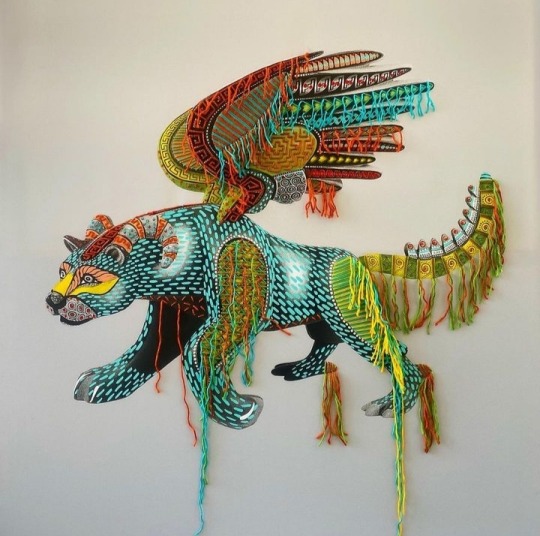
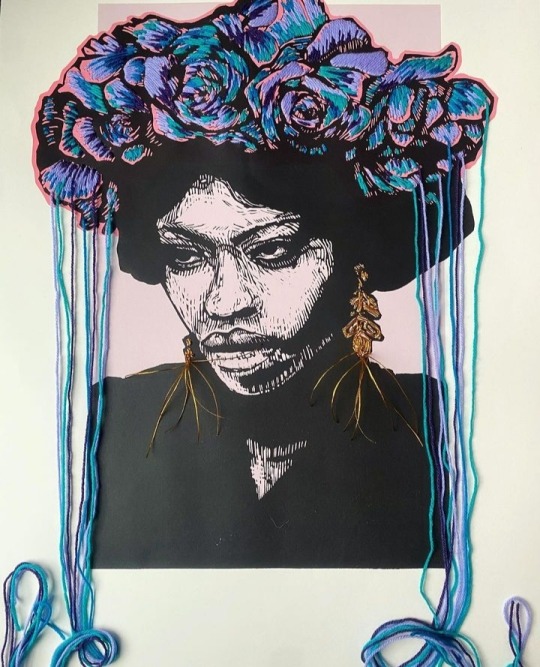
Victoria Villasana es una de mis artistas favoritas desde que vi su trabajo se generó en mi un acercamiento más cercano con los textiles, pues se tejer y estoy aprendiendo a bordar, el hilo siento que es algo muy bonito y con lo cual se podría hacer un gran proyecto y pues dentro de esto también valoro mucho los textiles mexicanos como artesanía y esta artista en una referencia para el planteamiento de nuevas ideas.
El sonido es algo muy importante me gusta pensar es esta idea de que imagen y sonido se construyen de sí mismas al igual que el sonido es movimiento como en un video, el trabajo de Manuel Ponce me gusta pues esta música "clásica", es una particularidad que muy pocos conocen, como se habrán dado cuenta me gusta más que nada resaltar estas características más culturales y pasadas de México, como que en este momento esa es mi línea de interés que busco reflejar.
Planos de la Fotografía
Gran Plano General:Es un plano descriptivo donde se desarrolla la acción.
Plano general:Describe el lugar figura humana cobra mayor protagonismo.
Plano Americano: Corta el personaje por las rodillas
Plano Medio: Corta al sujeto por las rodillas.
Primer Plano: Corta al personaje por los hombros.
Picada: La acción es grabada o tomada desde arriba.
Contrapocada: La acción se graba desde abajo.
Cenital: La acción se graba o toma desde arriba .
youtube
Pola Weiss Álvarez, (1947-1990) México
El trabajo que hizo Pola en su tiempo fue muy interesante, pues fue una de las pioneras del videoarte en México, lo que me llamo más la atención fue que como principal recurso para su trabajo ocupa al cuerpo, en sus videos hace referencia a que el arte y el cuerpo son uno mismo, conformando una nueva visión del cuerpo femenino.
youtube
Bill Viola
El trabajo de este artista contemporáneo diría que interesante, pero a mí me parece extraño, pues su trabajo va un poco a sus experiencias o traumas de su infancia, me parece raro, pues en lo personal, a quien le gusta recordar sus traumas del pasado, específicamente de la infancia, pero al mismo tiempo es innovador trabajar con tu pasado, para plasmarlo en tu presente y contexto contemporáneo.
¿Que es la armonía cromática?
Los tonos verdes producen sensación de frescura y equilibrio, aunque combinados con amarillos resultan más estimulantes. El azul es el color más frío, sugiere calma, reposo, quietud. Combinado con verde se reduce su frialdad y austeridad, equilibrando y aportando frescura al espacio
EJEMPLOS:
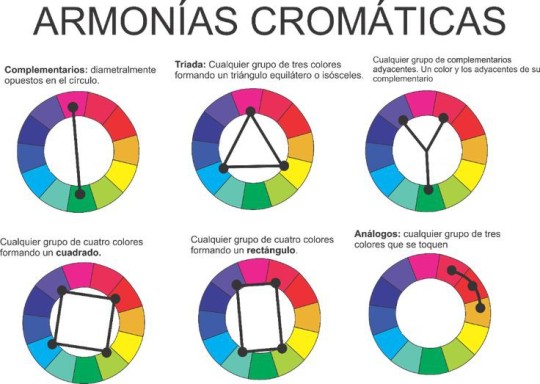
La armonía cromática es muy importante dentro de una producción de video arte, para tener clara la paleta de colores que deseamos seguir dentro de nuestra producción y que se vea más profesional.
Pantone Ejemplos:
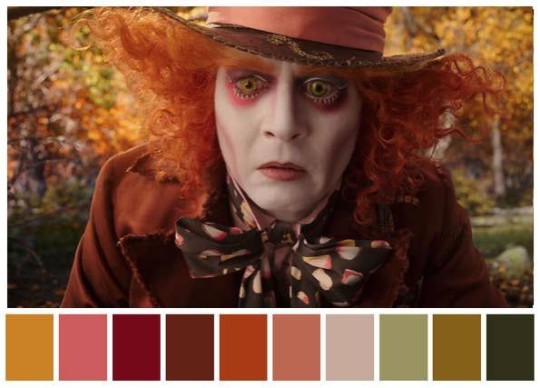
Alicia en el país de las Maravillas
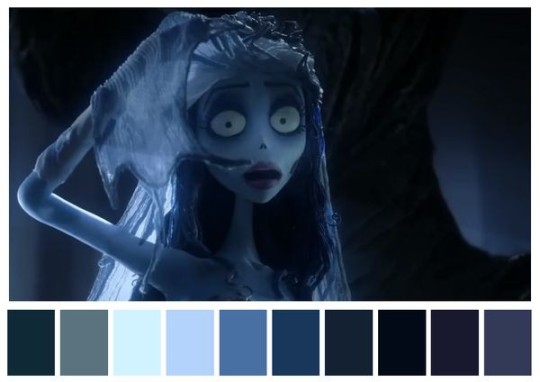
El cadáver de la novia
Importancia del sonido e imagen dentro de la producción artística.
Es fundamental que exista cierta armonía entre ambos elementos para crear un buen proyecto audiovisual. Un sonido que no encaja, o que no está sincronizado con la imagen, hará que tu vídeo pierda calidad, eston dos elementos deben ser importantes para que ambos se puedan complementar y no exista un desfase en tu resultado final.
Dato:
En freesound.com puedes encontrar una gran variedad de sonidos para tu producción artística de manera gratuita
3 notes
·
View notes
Text
Hey!! It's Teddie again, welcome back. Today we're talking software.
When I hear the word software, it’s really hard to come up with any kind of tangible definition. I know of computer software, that it exists, and that I probably see it every day, but I couldn’t explain to you exactly what it is or where it might be hiding. I think of the tiny panels inside my phone, circuit boards glued together with tiny signals somehow wirelessly escaping my little interface and travelling around the world to deliver bits of information. Thankfully, in his book Software Takes Command Lev Manovich reveals that software isn’t the mystical fibre optic cables or hard drives; instead, it’s actually the thing that brings the hard-wired confusion of computer science to meet the real, living world — “the very grounds and ‘stuff’ of media design”, Manovich quotes a colleague. But not only is it “stuff”, it’s also the very thing that connects us to everything digital, from Google to Photoshop, Facebook to the compass app on your phone (that I know you never use). Ironically, something that people (myself included) know so little about is the only key to accessing the seemingly endless stream of information coming from the internet and other digital tools.
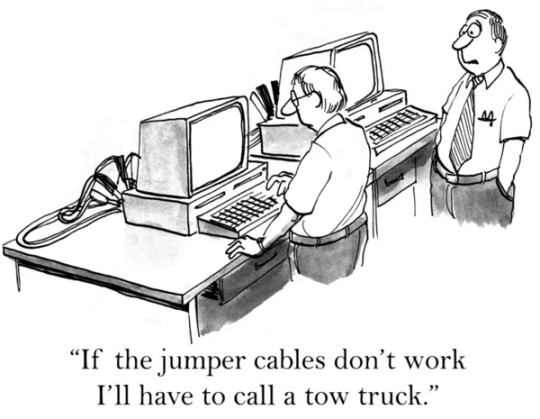
It’s for this exact reason, as Manovich points out, that software is constantly affecting and being affected by culture and society. Similar to the back and forth of art and literature, software is ever changing alongside cultural shifts in values and interests, serving as both a catalyst and a response to societal changes. But arguably unlike the arts, software reaches across the globe to impact billions of lives simultaneously, influencing a globalize society at the click of a button (or however it is the developers create software updates). It’s interesting to think about how a key driver of societal change is consciously being designed and redesigned for us consumers.

Although I can’t say it is the primary goal of software developers to generate large-scale societal shifts, I find it particularly interesting that they have that power to do so. Manovich describes, for example, a shift in privacy in the 2000s: “the boundary between “personal information” and “public information” has been reconfigured as people started to routinely place their media on media sharing sites, and also communicate with others on social networks.” When software introduces us to new (seemingly harmless) tools, such as an option to share a file, it can quickly take affect on society and, in this case, debase previously long-lasting values (such as that of privacy). A similar, more drastic effect came from the eruption of social media, as people were encouraged to spend more of their time sharing their lives rather than actually living them. Then, as Manovich mentions, these social affects can be taken advantage of; “By encouraging users to conduct larger parts of their social and cultural lives on their sites, these services can both sell more adds to more people and ensure the continuous growth of their user base.” Now, not only does a select community of people have a huge power over social and cultural change, but also they can enact changes that only they get rewarded for.

While software is far from the first or only thing initiating these cultural shifts, software is among the first to accept immediate feedback through engagement (and non-engagement) and human attention — while we can’t (or at least, don’t) dip our brushes into the drying paint of a Picasso to change its colours, we can engage with software to support or prevent its growth in the digital world. When we like a friend’s photo on Instagram, or click on an ad, we actively lay out a pattern of what software was successful and what wasn’t, not only through the type of interaction but also in whether we interact at all; and this data allows software to conform so tightly to common social and cultural values in a way that arts could never. In a similar way, engagement gives software an ‘insider access’ to human behaviour, giving it a power to shape the way we conduct our lives without even intending to. It’s interesting to think that something we know so little about knows and affects so much of the way we live.

*if you find these kinds of discussions interesting, I highly recommend watching “The Social Dilemma” on Netflix - it talks all about the role of the internet and globalization on the real world!
#social dilemma#software#software takes command#google#photoshop#engagement#globalization#softwarization#digitalization#internet#teddie speaks the truth
4 notes
·
View notes
Text
Critical analysis
Lev Manovich (2001), “Post-media Aesthetics”,Available at: https://manovich.net/index.php/projects/post-media-aesthetics
Has the concept of traditional art media become outdated in the cultural and technological changes of the late 20th century? Lev Manovich believes that the media categories that have long relied on, such as painting, sculpture, film, etc., have been overturned by emerging art forms, mass media, and digital technologies. However, although this framework is no longer applicable, it continues to exist due to institutional inertia and a lack of feasible alternative conceptual systems.
This article explores the changes in contemporary art and culture based on media classification frameworks, revealing the impact of technological and cultural changes on artistic practice. At the same time, traditional classification methods have limitations in the current era. I have chosen to analyze pages three to five of this article, which discuss the significant challenges brought by the digital revolution to traditional media. Combined with the impact of AI technology on the traditional art industry, including the digital technology industry, this will further break down the distinction between media. Personally, I think this is a very interesting topic.
Starting from the new art forms that emerged in the 1960s, such as installation art, conceptual art, and cross media art, they challenged traditional media classifications. Traditional art media are supported by physical objects such as paintings, sculptures, etc. Later, digital media also include cameras, tapes, DVDs, etc. These new forms often combine multiple materials and even attempt to separate artistic objects from simple material forms. The inclusion of photography, film, television, and video in artistic practice further complicates the classification of media. Traditional photography emphasizes capturing moments, while film is an art appreciated in specific situations and conditions, which are classified as time art and space art, respectively.
video and television share the same material basis and viewing conditions: watching on self media blurs this boundary. The digital revolution of the 1980s and 1990s disrupted the concept of media. Digital tools unify the creation and processing of different media, eliminating differences between forms such as photography, painting, film, and animation. The multimedia and global accessibility of the internet have made art no longer privatized but openly displayed and even used by others. Similarly, fanart on the internet, like memes, have disrupted the traditional media based artistic identity of art. The new categories of "online art" and "interactive art" continue the old practice of dividing art based on materials or technology.
At the same time, the distinction between art and popular culture has introduced new standards, such as audience size, distribution methods, and economic systems. Artworks are usually created in limited editions using mass media technology, which conflicts with the traditional art economy. Due to popular culture and online media, art resources are quickly leaked and become part of big data. The uniqueness of art is quickly disseminated through AI's efficient learning and following trends. Manovic criticized this method in the article, stating that such classifications often fail to consider differences in user acceptance and interaction. Compared to traditional art, media such as photography, painting, film, animation, etc. that are released on self media lack touch and cannot bring experiences of time, texture, and atmosphere. He proposed replacing outdated media classification frameworks with new concepts from computer and network culture. Future discussions should focus on artistic practices under post digital and post internet cultural conditions.
Nowadays, traditional media classification can no longer describe contemporary art and culture. The new conceptual framework shaped by digital and online reality is gradually emerging. The article highlights the tense relationship between technological determinism and human agency. Although digital tools facilitate new forms of integration and interaction, they do not determine artistic practice or audience interpretation. This indicates that the future of art will be shaped by the complex interaction of technology, culture, and social factors, rather than simply shifting from media classification to post media frameworks.
0 notes
Text
Blog 1 - Animation - the postmodernist visual medium

Though Live action film and animation both have the same foundations, the evolution of cinema theory and the insistence on the indexical quality of cinema and as well as the celluloid had caused them to become estranged to a point where animation is even wrongfully considered a genre of cinema, instead of a medium.
Early film theorists such as Andre Bazin argued that it was cinema’s ability to preserve and represent reality that was at the core of what made cinema an art form, “The cinema is objectivity in time.” (Bazin, 1967). the physical aspect of cinema was important.
However with the advent of digital media, such definitions are challenged. As live action material is combined with visual effects and animation, where the footage is manipulated frame by frame, the representation of reality is no longer the prime focus and now cinema can no longer be clearly distinguished from animation (Lev Manovich, 1995).
So it becomes necessary to expand on the qualities of cinema as a hybrid artform, one that combines narrative, composition of the frame, manipulation of time and space, music, performance and dialogue to fully realize the potential of cinema as a medium. (Noël Carroll, 1985). In the rapidly changing technological market such an expansion is almost necessary.
Another important aspect to consider is Cinema's ability to represent movement, it is in capturing movement in time that cinema is able to set it self apart from other works of art, by doing so the "spirit" of cinema would be achieved. (Irzykowski, 1977).
Considering these broad definitions of the inherent qualities of cinema as well as the changes brought to it by the advent of digital media, Animation has becomes once again a dominant medium of cinematic storytelling. (Lev Manovich, 1995).
Now i will analyze a small sequence from the animated movie Kung fu Panda 2 to highlight how an animation movie has been able to combine the different strengths of the cinematic medium to create an impactful sequence.
youtube
While animation is generally used as an umbrella term, it is made up of many different techniques. the two most popular being 2D hand drawn animation and computer generated 3D animation.
3D animation comes with the capacity to make incredibly detailed and lifelike images promoting a sense of realism, whereas 2D animation gives more room for exaggeration and a more abstract aesthetic.


This difference in mediums is used excellently to bring home to the viewers the difference between reality and memory of the character. The inherent potential for realism in 3D is contrasted with the abstractness and heightened reality of 2D. It also helps convey the separateness and deniability that the character has associated with the memory by keeping it two different mediums.
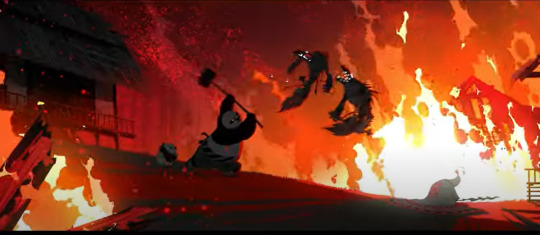
Bright warm and contrasting colors are used effectively in the 2D sequence to not just convey the intensity of the memory and danger that the characters in it are under but the nightmarish aspect the main character associates with it as well.
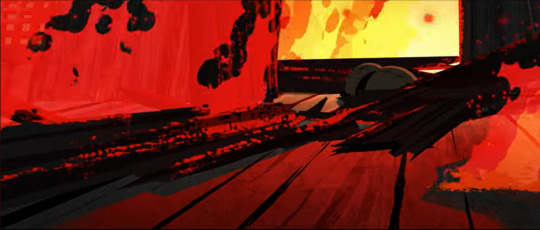
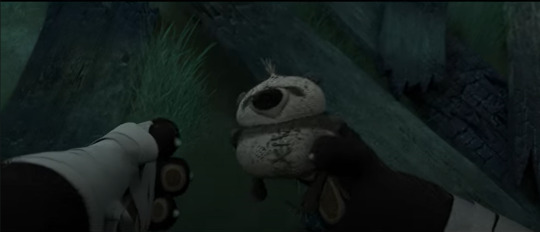
As the scene progresses and the lines between both memory and reality begin to blur, objects from the memory get converted into 3d objects, emphasizing the fact that the memory is not just a nightmare that the character has but rather a very real incident from his past. It also is a visual representation of the acceptance the character is experiencing of his past, which had kept him away from achieving "inner peace".
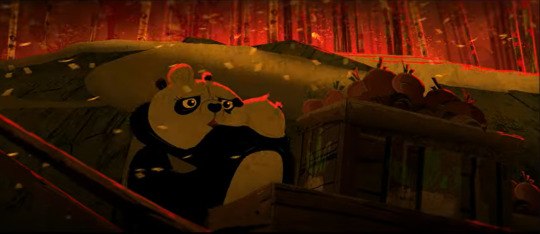
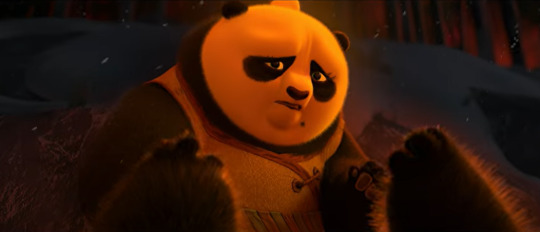
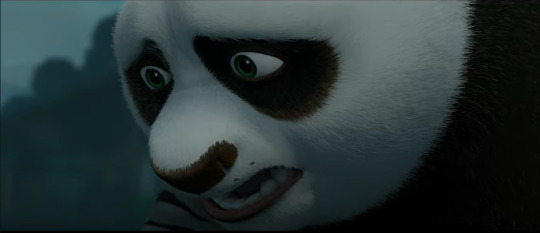
This visual metaphor comes to a conclusion as the 2D memory is suddenly replaced with a realistic 3D animation, signifying the characters acceptance of his past and the realness of the memory. However, the colors in the memory are still warm with a soft glow around the characters, which could be to signify not just the heat in the forest but the warmth of a mothers love.
This is an excellent example of using two different types of animation to not just create a visually stunning sequence but one that is paramount to the narrative and the development of the character.
It also takes advantage of the temporal properties of cinema, the back and forth edit between the past and the present helps not only the audience figure out the narrative faster but also puts us into the mind of the character. Time is almost faster in the sequences that are his dreams to heighten the danger and desperation in the situation which also helping us feel the characters own panic. It is slowed down when the character begins to find peace in himself. The sequence also ends with a montage which charts his whole journey in the first film that supplements and brings home the point of the dialogue that precedes it.
Movement is also emphasized to show the character finally achieving peace in himself while also using it as a clever way of transitioning between reality and the memory.
The sequence is also elevated by the choices the dialogue used and the music which reaches its crescendo as the character goes through his transformation. Dialogue is used only give the slightest of exposition and an interplay of both dialogue and visual storytelling is used to let the audience understand the whole narrative. A prime example of the "show, don't tell" rule.
While this was a small sequence in a movie, i felt like this was a really good example of what animation means to digital cinema and how easily it integrates and elevates its aspects to tell a memorable narrative, making the case for animation to be the post modernist medium for visual storytelling.
Citations:
Bazin, A. and Gray, H., 2005. What Is Cinema? Volume I. 1st ed. Berkeley: University of California Press. Available at: http://www.jstor.org/stable/10.1525/j.ctt5hjhmc
Manovich, L., 2001. What is digital cinema? In: N. Mirzoeff, ed., The Visual Culture Reader. 2nd ed. London: Routledge, pp. 285-298.
Gehman, C. and Reinke, S., 2005. The sharpest point: Animation at the end of cinema. Toronto: YYZ Books.
Carroll, N., 1985. The specificity of media in the arts. Journal of Aesthetic Education, 19(4), pp.5–20. https://doi.org/10.2307/3332295
Kuc, K., 2016. Karol Irzykowski and Feliks Kuczkowski: (Theory of) Animation as the cinema of pure movement. Animation, 11(3), pp.284–296. https://doi.org/10.1177/1746847716660685
Manovich, L., 2001. The language of new media. MIT Press.
The Unusual Shen Fan, 2023. [Kung fu panda 2 - Po finds the truth 4k]. [YouTube video] Available at: https://www.youtube.com/watch?v=ANmNtzyVyaY&ab_channel=TheUnusualShenFan
Hushain, J., Gupta, V. & Sharma, M., 2023. An analysis of the various kinds of animation. Vol. 10, pp. 160–166.
0 notes
Text
The Academic Blog Post 05
Exploring Intertextuality, Transmedia, and Hyperdiegesis in Spider-Man: Into the Spider-Verse

Figure 1: Miles Morales in the Spider-Verse
The Spider-Man- Spider-Verse is irregular which is animated movie that challenges which is unusual for the most famous cultural depictions of superhero movies and integrates for comic books which are trendy in the market within a movie plot. It offers itself as a textbook example of transmedia hybridity—the border between the art of the cartoonist of the pre-Tezuka era, the animated cartoon effects of the postwar Japanese animators, and the digital cinema of the contemporary world). This paper analyses/ discusses the film as a Gesamtkunstwerk and seeks to examine how the filmmaker employed the spirit of the medium specificity in coming up with a special vision. This series is the best example of executing the various ideas of Gesamtkunstwerk since it has many forms of various ideas and of arts that differ in it and nothing of them overshadows the other.

Figure 2: The Multiverse in Action
Make use of funny or comic books and animations such as 3D which are aesthetic sensibility and accompanied by a musical style it becomes the best experience. Beautiful colors, which are combined by music effectively also touch the plot of the characters of the Spider-Verse successfully intertwining these various elements in one authentic piece. Unlike recent films which alternately recount parallel stories, the flexible and constantly shifting composition of panel solutions in conjunction with the smooth bridging of the universes accentuates the movie’s impact on the audience as Wagner envisioned the perfect Gesamtkunstwerk. Only in regards to the medium specificity, Spider-Verse makes use of animation to provide the viewers with ideas and emotions that could not have been reached in live-action. Some effects such as halftone dots, motion lines, and on-screen text attempt to ape the aesthetics of printed comics to project this look and feel quite close to its inspiration. Unlike all the live-action movies of Spiderman, this animated feature is liberal with hand-drawn elements with computer graphics, which opens up possibilities of truly outstanding scenes such as the one involving colors during jumping between dimensions. As Lev Manovich pointed out, the post-media condition means that no medium becomes dominant, and animation proves that creativity can step over the limits of the media hierarchy.
References:
Sony Pictures Entertainment. (2018). Spider-Man: Into the Spider-Verse - Official Trailer. YouTube. Retrieved from https://www.youtube.com/watch?v=tg52up16eq0.
Walulik, A. (2021). Into the Spider-Verse is a masterclass in animation and storytelling. The Nerd Report. Retrieved from https://medium.com/the-nerd-report/into-the-spider-verse-is-a-masterclass-in-animation-and-storytelling-5b671e57d1e6.
1 note
·
View note
Text
Blog 4
Tools - The concept of Medium Specificity and Gesamtkunstwerk and its relation to my work.
I will be analyzing my work and whether it fits into the the broader concept of Medium Specificity or Gesamtkunstwerk. Firstly I will describe the details of my work and then my opinion on its relation to these concepts.

Fig 1 : The artwork.
This artwork (Fig 1) was what I created for one of the projects in my practice development. It was not the final piece but i choose this for the analysis because of its uniqueness. My idea behind this artwork was to show a part of me as one of the things I like and find joy in. I have been a huge motorcycle enthusiast as a child and one of my favorite motorcycle brands is the Harley Davidson and so I planned on showcasing the brand as a part of myself. The left side is a portrait of myself which I attempted on Adobe's Illustrator and the right side are words in shapes that resemble my face which i made entirely in Photoshop.
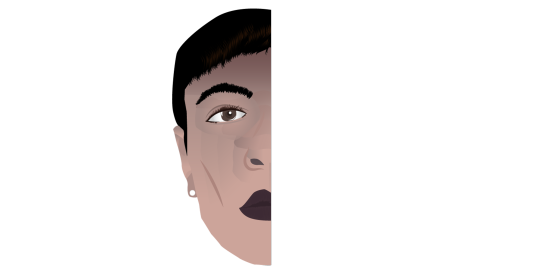
Fig 2 : The 2D vector portrait.
Starting with the left side of the art work (Fig 2), it is a completely 2 dimensional vector portrait that I made using the pen tool. Whereas on the right side the words are completely 3 dimensional (Fig 3), although I first made it in 2D in Illustrator and later gave it a more 3D outlook (Fig 5) and also applied a chrome texture (Fig 4) on it to give it a more metallic outlook as most of Harley's parts are made out of chrome.
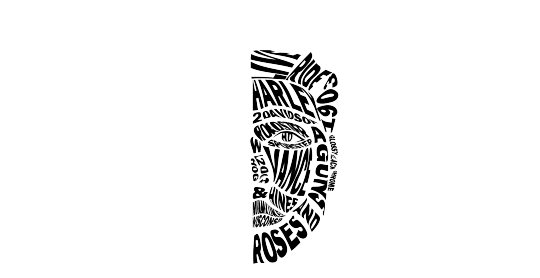
Fig 3 : 2D words.

Fig 4 : The chrome texture I applied on the words.
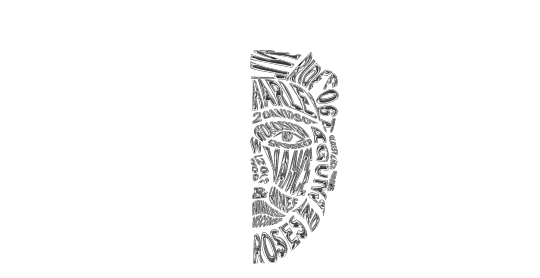
Fig 5 : The 3D outlook of the words with the chrome texture.
Now for the analysis, as described in the module the concept of medium specificity advocates for the individualness of artworks and that art forms should not be mixed and art should remain media specific. As stated by Clement Greenberg, "A modernist work of art must try, in principle, to avoid dependence upon any order of experience not given in the most essentially construed nature of its medium. This means, among other things, renouncing illusion and explicitness. The arts are to achieve concreteness, "purity," by acting solely in terms of their separate and irreducible selves." (Greenberg, 1961). As described in the module, the term "Gesamtkunstwerk" was first used by a German philosopher Karl Friedrich Trahndorff in 1827 which was further popularised by German composer Richard Wagner in the mid 19th century. "Gesamt" stands for whole, entire, total whereas "Kunstwerk" stands for artwork which basically means a total work of art. In contrary to the concept of medium specificity, the concept of Gesamtkunstwerk is basically an artwork, design, or creative process that combines various artistic mediums to produce a single art piece. This concept is more focused on impact of the art piece on its viewer. I think the concept of medium specificity was more relevant in older times when there was a lack of technological advancements. There was not much a artist could do to 'mix' different art forms, however the idea of media being 'pure' is hugely outdated. There is so much more at the hands of artists where it becomes meaningless to limit art to one specific medium. Instead with the rise of technology it makes it easier to combine several mediums to produce one good piece of work, as stated by Lev Manovich in "The Language of New Media", “Regardless of how often we repeat in public that the modernist notion of medium specificity("every medium should develop its own unique language") is obsolete, we do expect computer narratives to showcase new aesthetic possibilities which did not exist before digital computers. In short, we want them to be new media specific” (Manovich, 2001). Combining different mediums opens space for new possibilities which can result in a better viewer engagement as well as can drastically change the viewer's opinion of the artwork as also stated by Peter Weibel, "The blending of the media leads to extraordinary innovations both within the relevant media and art. Painting is not revitalised through itself but through the reference to other media. Video lives through film, film lives through literature and sculpture lives through photography and video. They all live through the digital innovation." (Weibel, 2005). Considering my work, I would have made it somewhat less eye appealing had I stuck with one medium. The artwork would have not been as impressive and engaging if it was entirely a vector portrait, instead the combination with a 3D medium gives it a better meaning overall. Adding the chrome effect on 3D words allowed me to bring in the idea of chrome used in Harley bikes which ultimately boosted the overall appeal of the art piece and made it relatable. limiting it to 2D only, would have made it somewhat simpler and less expressive which would have reduced its overall appeal for the viewer and therefore I would say I relate more with concept of Gesamtkunstwerk as rather than the 'purity' of the art, an artist must focus more on the arts appeal and its meaning.
References
Greenberg, C. (1961) Art and Culture : critical essays, Beacon, Available at : https://monoskop.org/images/1/12/Greenberg_Clement_Art_and_Culture_Critical_Essays_1965.pdf
Manovich, L. (2001) The Language of New Media, , Available at : https://dss-edit.com/plu/Manovich-Lev_The_Language_of_the_New_Media.pdf
Weibel, P. (2005) The Post-Medial Condition, Arte ConTexto, no. 6, pp. 11–15, Available at : https://www.ocopy.net/2017/01/18/peter-weibel-the-post-medial-condition-2005/1
0 notes
Text
Blog Post- 10
Analyzing Virtual Reality Through Theoretical Frameworks
Introduction-
Virtual Reality (VR) has grown rapidly over the past decades, starting as a niche technology from entering into mainstream tools for gaming, education, healthcare, and arts. A fully digital environment is created in the physical world with the help of VR, along with Augmented Reality (AR) and Mixed Reality (MR). These technologies promise new possibilities for interaction and engagement. However, VR comes with its own challenges. Questions about its impact on perception, identity, and society need to be explored. In this post, I will analyze VR through various theoretical frameworks, drawing on the work of scholars such as Alison McMahan, Lev Manovich, and posthumanist theorists, while considering how these perspectives deepen our understanding of VR’s potential and limitations.
Theoretical Frameworks for Analyzing Virtual Reality:
1. Alison McMahan’s Theory of Immersion, Engagement, and Presence-
In her seminal work, Immersion, Engagement, and Presence: A Method for Analyzing 3D Video Games, Alison McMahan outlines a framework for understanding the psychological effects of interactive digital environments like VR. McMahan defines immersion as the sense of being surrounded by a virtual environment, engagement as the depth of the user’s interaction with that environment, and presence as the feeling of "being there" (McMahan, 2003). According to McMahan, the power of VR lies in its ability to create an intense feeling of presence, where the user's actions have real consequences within the virtual space.
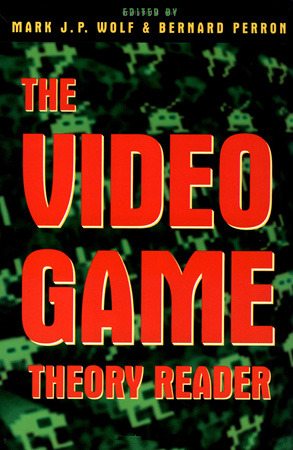
What does McMahan's theory reveal? McMahan's framework helps us understand the active participation of the user instead of being a passive observer. The theory is particularly relevant when analyzing VR’s use in storytelling, gaming, and virtual tourism, where users can physically move through and alter the environment, thereby creating a profound sense of immersion.
2. Lev Manovich’s Media Theory-
Lev Monavich offers a perspective on VR that is rooted in his broader theory of digital media, this theory is mentioned in The Language of New Media. Monavhich argues that the new media reconfigures our interaction with content, this includes VR-driven content. Unlike traditional media where the viewer is a passive observer, VR allows users to interact, manipulate, and explore in a non-linear way (Manovich, 2001). This sense of being a part of the virtual environment is at the core of VR's appeal, enabling a deeper connection to the content.
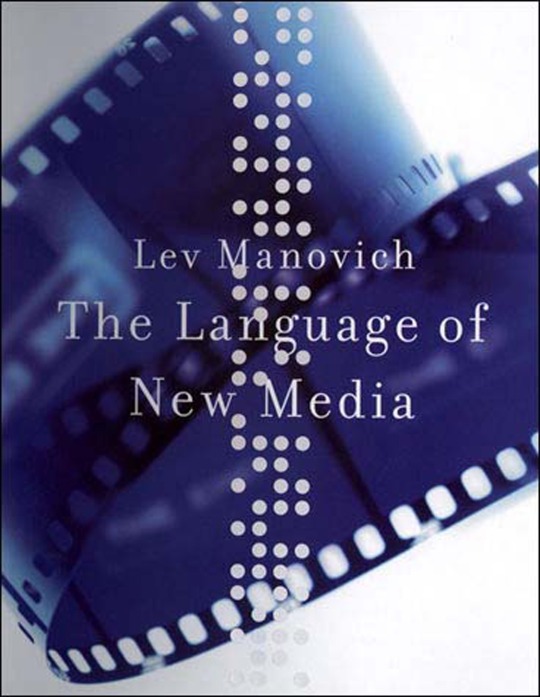
What does Manovich’s theory reveal? By analyzing interactivity, Monavich's theory helps us understand that VR is not just about passive engagement but about the active role users take in creating meaning within the virtual space. This view is essential for understanding VR’s potential in education, where users can engage with material by exploring interactive environments, or in gaming, where players influence the outcome of the narrative.
Virtual Reality in Art-
We can consider the VR installation Tree by Marshmallow Laser Feast a good illustration of these frameworks. This immersive experience invites users to embody a tree and explore its structure with the surrounding environment. The installation uses VR to engage users cognitively and emotionally with nature.
McMahan’s Theory: The VR experience in Tree creates a deep sense of presence, where users feel physically embedded within the tree’s environment. The emotional engagement is intensified by the interactive nature of the installation, which allows users to perceive the tree from different angles and experience its surroundings.
Manovich’s Media Theory: In Tree, users interact with the virtual tree by manipulating their virtual perspective, offering a non-linear, interactive exploration of nature. The immersive nature of the experience is a direct result of the interactivity at its core, allowing users to shape their encounter with the virtual world.
Enhancing My Own Work with VR/AR/MR-
As a creator, I am interested in how VR/AR/MR could expand the scope of my interactive art. My current work involves creating a space environment where the audience's physical movement influences the visual experience. Introducing VR could immerse the audience in a fully three-dimensional, interactive spacial environment, where users can explore and manipulate the surroundings with their gestures.
What would my work gain from VR? VR would allow for deeper interactivity and immersion, offering the audience a chance to engage with my work on a more personal and participatory level. The extra-terrestrial experience would be heightened as users could move through virtual spaces, creating a more engaging and dynamic encounter with the artwork.
What are the risks? The primary risk of using VR is the potential for sensory overload. If the virtual environment is too complex or overwhelming, it could detract from the emotional or conceptual message I intend to convey. Additionally, VR could isolate the audience by making the experience individual rather than communal.
Wrap up-
Virtual reality offers transformative possibilities for art, education, gaming, and beyond. By analyzing VR through the theoretical frameworks, we can obtain a deeper understanding of its potential to reshape our experience of space, identity, and interaction. While created are being presented exciting opportunities through the progress of VR, it also raises critical questions about the boundaries between the virtual and the real, the role of interactivity, and the potential risks of sensory overload or isolation. As these technologies continue to evolve, it is essential to approach them thoughtfully, considering both their potential and their limitations.
Reference List-
www.immersence.com. (n.d.). Alison McMahan (2003). Immersion, Engagement, and Presence. A Method for Analyzing 3-D Video Games. [online] Available at: https://www.immersence.com/publications/2003/2003-AMcMahan.html.
McMahan, A. (2003). Immersion, engagement, and presence: A method for analyzing 3-D video games. [online] Available at: https://www.researchgate.net/publication/284055280_Immersion_engagement_and_presence_A_method_for_analyzing_3-D_video_games.
Penguin.com.au. (2024). The Language of New Media by Lev Manovich. [online] Available at: https://www.penguin.com.au/books/the-language-of-new-media-9780262632553 [Accessed 23 Dec. 2024].
Marshmallow Laser Feast. (n.d.). Works of Nature. [online] Available at: https://marshmallowlaserfeast.com/project/works-of-nature/.
0 notes
Text
Week 6, Blog 4
The animated short film 'Alephia', explores themes of transformation, identity, and memory through a surreal, abstract visuals and non-linear storytelling. When viewed through Carl Jung’s theory of the collective unconscious, Alephia’s characters and settings can be seen as archetypes, symbols of universal fears and desires that offer a psychological dimension to the film. This approach aligns with how surrealist art often expresses deep, subconscious ideas.
Comparing 'Alephia' to Don Hertzfeldt’s 'World of Tomorrow', we see both films explore memory and identity, though Alephia emphasizes pure visual storytelling over dialogue. Lev Manovich’s theories on digital art also deepen our understanding, as he discusses how digital mediums can challenge reality and narrative. Overall, Alephia becomes not just a story but an immersive, symbolic experience reflecting inner journeys and universal themes.
0 notes
Text
Oh, oh, oh, Henry Jenkins is AWESOME! Check out "Pop Cosmopolitanism: Mapping Cultural Flows in an Age of Media Convergence" (from 2006) as well, where he explains the difference between CORPORATE convergence and GRASSROOTS convergence:
"Corporate convergence – the concentration of media ownership in the hands of a smaller and smaller number of multinational conglomerates who thus have a vested interest in insuring the flow of media content across different platforms and national borders. Grassroots convergence – the increasingly central roles that digitally empowered consumers play in shaping the production, distribution, and reception of media content."
But also!!! good fandom academia texts!
Judith Butler: "Implicit Censorship and Discursive Agency" (1997)
and!
Abigail de Kosnik, "Fandom as Free Labor" (2012):
"Online fan productions constitue unauthorized marketing for a wide variety of commodities – almost every kind of product has attracted a fandom os some kind." ... "Fans are eager to praise what is right about an object, point out what is wrong, and propose solutions and new directions for the development of that object because they think that fandom is what completes and perfects the object." ... Media fans, Jenkins observes, write fan fiction and fan commentary, and make art and music and videos, as a way to create their version of a text, the text as they would like it to be, the text that serves their needs best. From Jenkins, we learn that fan labor is often the work of customization, the making of mass-produced things into things that serve individuals' particular and peculiar desires and wishes."
(and Tiziana Terranova's "Free Labor" from 2000 which de Kosnik's text is based on:
"[Free Labor is] this excessive activity that makes the internet a thriving and hyperactive medium, [...] a feature of the cultural economy at large and an important, yet unacknowledged, source of value in advanced capitalist societies")
and!
Matt Hills, "Proper Distance' in the Ethical Positioning of Scholar-Fandoms: Between Academics' and Fans' Moral Economies" (2012)
and!
Christian Fuchs, "Social Media and Capitalism" (2013):
"Corporate social media are not a realm of user/prosumer participation, but a realm of Internet prosumer commodification and exploitation. The exploitation of Internet prosumer labour is one of the many tendencies of contemporary capitalism. It is characteristic for a phase of capitalist development, in which the boundaries between play/labour and private/public become blurred."
and!
Melanie Kohnen, "The Power of Geek: Fandom as a Gendered Commodity at Comic-Con" (2014)
and!
Lev Manovich: "The Practice of Everyday (Media) Life: From MassConsumption to Mass Cultural Production" (2009):
"The explosion of user-created media content on the web (dating from say, 2005) has unleashed a new media universe. (Other terms often used to refer to this phenomenon include social media and user-generated content). ... Manovich also says that Web 2.0 has triggered "a fundamental shift in modern media culture" ... "The developments of the previous decade [...] led to the explosion of user-generated content available in digital form: web sites, blogs, forum discussions, short messages, digital photos, video, music, maps, and so on." ... "Since the companies that create social media platforms make money from having as many users as possible visit them [...], they have a direct interest in having users pour as much of their lives into these platforms as possible." ... "[Conversations between users and fans] play increasingly important roles in shaping professionally produced media. Game producers, musicians, and film companies try to react to what fans say about their products, implement fans' wishes and even shape story lines in response to conversation among cultural consumers.
and!
Suzanne Scott "Who's Steering the Mothersip? The Role of the Fanboy Auteur in Transmedia Storytelling" (2013):
"Defined by Henry Jenkins (2007) as "a process where integral elements of a fiction get dispersed systematically across multiple delivery channels for the purpose of creating a unified and coordinated entertainment experience," transmedia storytelling has been celebrated by media scholars as a narrative model that promotes collaborative authorship and participatory spectatorship. […] Transmedia stories are defined by their ability to expand: they expand and enrich a fictional universe, they expand across media platforms, and they empower an expansive fan base by promoting collective intelligence as a consumption strategy"
anyways fandom academia is <3333 y'all
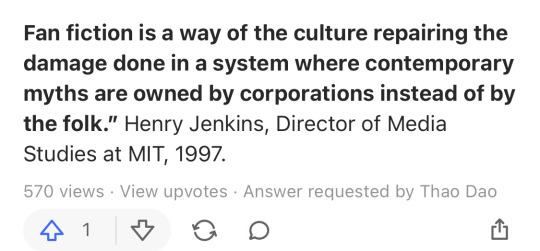
💥🙌👏
166K notes
·
View notes
Text
Narrative/Database redux
It seems common and at the same time exceedingly difficult to make historical claims about the role of narrative in cultures: not only to to classify the kinds of narratives that circulate within and shape a given culture, but also to establish what constitutes narrative activity itself, to judge its relative importance in that culture’s (self-)understanding against other modes of knowledge, and to furnish an explanation for any changes in its status. Jean-François Lyotard’s Postmodern Condition: A Report on Knowledge (1979) attempts something like this: it registers a “crisis of narratives,” and asserts, in an “extreme” but memorable simplification, that the “postmodern condition” is characterized by an “incredulity toward metanarratives” (xxiv). What Lyotard observes in the post-Marxist, post-structuralist French university is a situation in which “the narrative function is losing its functors, its great hero, its great dangers, its great voyages, its great goal.” The narrative function here is airborne, atmospheric, “dispersed in clouds of narrative language elements—narrative, but also denotative, prescriptive, descriptive, and so on” (xxiv). Patchy language games are figured (and disfigured) as word clouds, as “clouds of sociality,” masses of linguistic particles, whose edges are indistinct and whose commensurability is minimal. For Lyotard, traditional knowledge takes narrative form; the new cloudiness, on the other hand, is the result of a critical confrontation with scientific knowledge, which has always existed in a state of competition and conflict with narrative knowledge. Narrative knowledge is not strictly compatible with scientific knowledge—they are incommensurate language games—and yet the two are necessarily interlinked and in a way interdependent. There is a “return of the narrative in the non-narrative” (27).
Lyotard was already narrating such transformations in knowledge as effects of “information-processing”; he refers to post-WWII modes of bureaucratic and technocratic thinking associated with early processes of digitization: informatics and information theory, systems theory and cybernetics. The burgeoning “computerized societies,” Lyotard writes, are societies through which the “nature of knowledge cannot survive unchanged” (3–4). Lyotard believes that this change will essentially have to do with a crisis of legitimation of narrative knowledge in which narrators and narratees become subjects of vast (and often privately controlled and managed) “data banks” from which it is only ever possible to generate “little narratives” with “local determination” (60).
Around two decades later, once a significant amount of “information-processing” had moved from mainframes to networked personal computers, it became possible to speak of “new media” and “computer culture,” and to evaluate their effects on narrative culture. In The Language of New Media (2002), Lev Manovich makes a distinction that resonates with Lyotard’s: not between narrative and science, but between narrative and database. Manovich, I think, actually relies on Lyotard’s work more than he cites him, providing updates to many of the latter’s key insights. Manovich’s understanding is that narratives and databases may be regarded as “symbolic forms” (following Ervin Panofsky’s history of perspective) that may have more or less prominence in an age, and from the perspective of the late nineties and early aughts, it seemed that databases were supplanting narratives. Databases and narratives are “natural enemies” (225): narratives are stories with beginnings and ends, and with actors who cause, experience, and reflect upon events, while databases, on the other hand, are structured collections of data that can be traversed in a number of ways, only one of which might be narrative (which is “just one method of accessing data among many” [220]).
New media objects like websites, apps, and video games are often databases first, and narratives second (if at all). Using the vocabulary of Saussurean semiology, Manovich claims that they reverse the relationship of syntagm and paradigm. In semiology, the aim was to derive paradigms (or “codes”) which were virtually present in languages, myths, and other syntagmatic utterances (what Saussure called parole). With new media technologies—effects libraries, menus of commands, stock assets, digital games—it is the paradigms which are given, and the syntagmatic dimension which is virtual. “The complete paradigm is present before the user, its elements neatly arranged in a menu” (231). The inscription of paradigms in digital memory can be understood as the technological a priori that conditions much of the transmedia storytelling described by Henry Jenkins, for example, in which world-building and asset management leads, and narrative follows. The convergent logic of the computer, Manovich’s “universal media machine,” becomes the logic of culture at large (236).
Manovich is actually slightly unclear when it comes to the question of medium specificity and media determination—he prefers to think of database/narrative forms outside of any correlation with specific media technologies (“as two competing imaginations, two basic creative impulses, two essential responses to the world” [233]) but a few pages later asserts that the database form is “inherent to new media,” with the digital computer as its “perfect medium” (237, 234). In any case, Manovich gives a number of examples of works in various media—cinema, photography, art—in which the database impulse takes precedence, and in which any temporal succession is detached from a narrating subject or narrative actors, making narrative implicit at most. In the cinema of Peter Greenaway or Dziga Vertov, we are presented with catalogs of events, in which database procedures like sorting and and linking are foregrounded. Greenaway’s work in particular demonstrates quite well how cinematic narrative may be minimally wrapped around around databases ordered by simple algorithms. In Vertical Features Remake (1978), The Falls (1980), The Draughtsman’s Contract (1982), A Zed & Two Noughts (1985), Drowning By Numbers (1988), Prospero’s Books (1991), and other films, narrative persists, but it is subsumed by database operations that exceed it, namely counting and re-sequencing. “Old media” like cinema are particularly adept at registering or transcoding the effects of “new media,” just as “new media” are always incorporating and simulating, to different degrees, features of “old media.”
It is important to think culture algorithmically, as Lyotard had begun to do and as Manovich continues to do, while also being sensitive to the ways in which “pre-digital” objects—and not only Vertov’s cinema and structuralist cultural theory—already made use of databases and algorithms. I find Manovich’s identification of cinema as a database medium to be useful, given outsized influence in twentieth-century media ecology, but I think that the starting point of this media-theoretical narration—as Wolfgang Ernst and other media archaeologists have recognized—can always be moved further and further backward. A wider media-historical scope may provide new perspectives on the fractured, cloudy media landscape of today’s algorithmic culture, which in many ways has surpassed the imaginations of both Lyotard and Manovich.
References
Ernst, Wolfgang. 2013. Digital Memory and the Archive. Minneapolis: University of Minnesota Press. Jenkins, Henry. 2006. Convergence Culture: Where Old and New Media Collide. New York: NYU Press. Lyotard, Jean-François. 1979. The Postmodern Condition: A Report on Knowledge. Minneapolis: University of Minnesota Press. Manovich, Lev. 2001. The Language of New Media. Cambridge, MA: The MIT Press.
2 notes
·
View notes